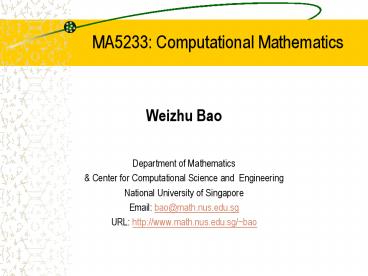MA5233: Computational Mathematics - PowerPoint PPT Presentation
1 / 37
Title: MA5233: Computational Mathematics
1
MA5233 Computational Mathematics
- Weizhu Bao
- Department of Mathematics
- Center for Computational Science and
Engineering - National University of Singapore
- Email bao_at_math.nus.edu.sg
- URL http//www.math.nus.edu.sg/bao
2
Computational Science
- Third paradigm for
- Discovery in Science
- Solving scientific
- engineering problems
- Interdisciplinary
- Problem-driven
- Mathematical models
- Numerical methods
- Algorithmic aspects
- computer science
- Programming
- Software
- Applications,
3
Dynamics of soliton in quantum physics
4
Wave interaction in plasma physics
5
Wave interaction in particle physics
6
Vortex-pair dynamics in superfluidity
7
Vortex-dipole dynamics in superfluidity
8
Vortex lattice dynamics in superfluidity
9
Vortex lattice dynamics in BEC
10
Computational Science
- Computational Mathematics Scientific
computing/numerical analysis - Computational Physics
- Computational Chemistry
- Computational Biology
- Computational Fluid Dynamics
- Computational Enginnering
- Computational Materials Sciences
- ...
11
Steps for solving a practical problems
- Physical or engineering problems
- Mathematical model physical laws
- Analytical methods existence, regularity,
solution, - Numerical methods discretization
- Programming -- coding
- Results -- computing
- Compare with experimental results
12
Computational Mathematics
- Numerical analysis/Scientific computing
- A branch of mathematics interested in
constructive methods - Obtain numerically the solution of mathematical
problems - Theory or foundation of computational science
- Develop new numerical methods
- Computational error analysis
- Stability
- Convergence
- Convergence rate or order of accuracy,.
13
History
- Numerical analysis can be traced back to a
symposium with the title Problems for the
Numerical Analysis of the Future, UCLA, July
29-31, 1948. - Volume 15 in Applied Mathematics Series, National
Bureau of Standards - Boom of research and applications Fluid flow,
weather prediction, semiconductor, physics,
14
Milestone Algorithms
- 1901 Runge-Kutta methods for ODEs
- 1903 Cholesky decomposition
- 1926 Aitken acceleration process
- 1946 Monte Carlo method
- 1947 The simplex algorithm
- 1955 Romberg method
- 1956 The finite element method
15
Milestone algorithms
- 1957 The Fortran optimizing compiler
- 1959 QR algorithm
- 1960 Multigrid method
- 1965 Fast Fourier transform (FFT)
- 1969 Fast matrix manipulations
- 1976 High Performance computing packages
LAPACK, LINPACK Matlab - 1982 Wavelets
- 1982 Fast Multipole method
16
Top 10 Algorithms
- 1946 Monte Carlo method
- 1947 Simplex method for linear programming
- 1950 Krylov subspace iterative methods
- 1951 Decompositional approach for matrix
computation - 1957 Fortran optimizing compiler
- 1959-61 QR algorithms
- 1962 Quicksort
- 1965 Fast Fourier Transform (FFT)
- 1977 Integer relation detection algorithm
- 1982 Fast multipole algorithm
- http//amath.colorado.edu/resources/archive/top
ten.pdf
17
Contents
- Basic numerical methods
- Round-off error
- Function approximation and interpolation
- Numerical integration and differentiation
- Numerical linear algebra
- Linear system solvers
- Eigenvalue probems
- Numerical ODE
- Nonlinear equations solvers optimization
18
Contents
- Numerical PDE
- Finite difference method (FDM)
- Finite element method (FEM)
- Finite volume method (FVM)
- Spectral method
- Problem driven research
- Computational Fluid dynamics (CFD)
- Computational physics
- Computational biology,
19
How to do it well
- Three key factors
- Master all kinds of different numerical methods
- Know and aware the progress in the applied
science - Know and aware the progress in PDE or ODE
- Ability for a graduate student
- Solve problem correctly
- Write your results neatly
- Speak your results well and clear presentation
- Find good problems to solve
20
Numerical error
- Example 1
- Example 2
- Example 3
- Example 4
21
Numerical error
- Truncation error or error of the method
- Round-off error due to finite digits of numbers
in computer - Numerical errors for practical problems
- Truncation error
- Round-off error
- Model error observation error empirical error
etc.
22
Absolute error
- Absolute error
- Absolute error bound (not unique!!)
23
Relative error
- An example
- Relative error
- Relative error bound
24
Absolute error bounds for basic operations
- Suppose
- Error bounds
25
Significant digits
- An example
- Definition n significant digits
- Method
- Write in the standard form
- Count the number of digits after decimal
26
Error spreading An example
- Algorithm 1
- Use 4 significant digits for practical
computation - Results
27
Error spreading An example
- Algorithm 2
- Result
- Truncation error analysis
28
Convergence and its rate
- Numerical integration
- Exact solution
29
Numerical methods
- Composite midpoint rule
- Composite Simpsons rule
- Composite trapezoidal rule
- Error estimate
30
Numerical results
31
Numerical errors
32
Observations
- Before h0
- Truncation error is too large !!
- After h1
- Round-off error is dominated!!
- Between h0 and h1
- Clear order of accuracy is observed for the
method - We can observe clear convergence rate for proper
region of the mesh size!!!
33
Numerical Differentiation
- Numerical differentiation
- The total error
34
Numerical Differentiation
35
Numerical Differentiation
- Total error depends
- Truncation error
- Round-off error
- Minimizer of E(h)
- Double precision
- Clear region to observe truncation error
36
How to determine order of accuracy
- Numerical approximation or method
- How to determine p and C??
- By plot log E(h) vs log h
37
How to determine order of accuracy
- By quotation






























